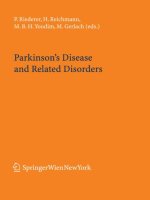PARKINSON’S DISEASE AND RELATED DISORDERS - PART 8 ppt
Bạn đang xem bản rút gọn của tài liệu. Xem và tải ngay bản đầy đủ của tài liệu tại đây (1.17 MB, 10 trang )
©2004 CRC Press LLC
Figure 61 Dystonic postur-
ing of the left big toe in a
patient who had experienced
an ischemic event in the right
cerebral hemisphere follow-
ing attempted removal of a
sphenoidal wing meningioma
Figure 60 Dystonic hand posture (same patient as in Figure 59)
©2004 CRC Press LLC
Figure 62 Histology in Wilson's disease shows
atrophy and rarefaction of the putamen (black
arrows). Loss of myelin bundles in the putamen
contrasts with the more normal appearances in
the globus pallidus (white arrow; Luxol fast blue)
Figure 63 Histology of brain
in Wilson's disease shows a
Bergmann type 2 astrocyte
within an atrophic putamen
(H & E)
©2004 CRC Press LLC
Figure 64 Histology of brain
in Wilson's disease showing
an Opalski cell (arrowed)
(H & E)
Figure 65 T
1
-weighted MRI
shows the presence of high-
signal areas (arrowed) in the
substantia nigra in a patient
with chronic acquired hepato-
cerebral degeneration
©2004 CRC Press LLC
Figure 66 T
1
-weighted MRI shows the presence of high-signal areas
(arrowed) in the pallidum in a patient with chronic acquired hepatocere-
bral degeneration
©2004 CRC Press LLC
Figure 67 Pedigree (upper) of a family with
Huntington's disease is accompanied by
DNA gels (lower) which indicate trinucleo-
tide repeats of between 40 and 52
©2004 CRC Press LLC
Figure 69 Histological section of brain in
Huntington's disease shows atrophy with loss of
neurons and astrocytic gliosis (immunocytochem-
istry preparation for glial fibrillary acidic protein)
Figure 68 Coronal section of
brain in Huntington's disease
shows symmetrical atrophy and
brown discoloration (arrowed) of
the caudate and putamen together
with dilatation of the lateral vent-
ricles
©2004 CRC Press LLC
Figure 70 CTs showing atrophy of the
caudate nucleus in a patient with Hunting-
ton's disease (upper) compared with a
normal subject (lower; arrowed)
©2004 CRC Press LLC
Figure 72 Coronal proton-
density MRI in a patient with
Huntington's disease shows
features similar to those in
Figure 71
Figure 71 Axial proton-density MRI in
a patient with Huntington's disease shows
areas of increased signal in both the cau-
date nucleus (white arrow) and putamen
(black arrow)
©2004 CRC Press LLC
Figure 73 PETscans showing integrated
11
C-raclopride and
11
C-SCH 23390 activity
in a normal subject (left) and choreic patient (right) with Huntington's disease. Both
D
1
and D
2
binding is reduced in the Huntington's patient in both the caudate and
putamen
©2004 CRC Press LLC
Figure 74 Axial T
2
-weighted MRI (upper)
of a patient with Hallervorden–Spatz disease
shows marked pallidal hypointensity (arrow-
ed). The coronal proton-density MRI (lower)
shows a similar picture together with an
anteromedial zone of high intensity









